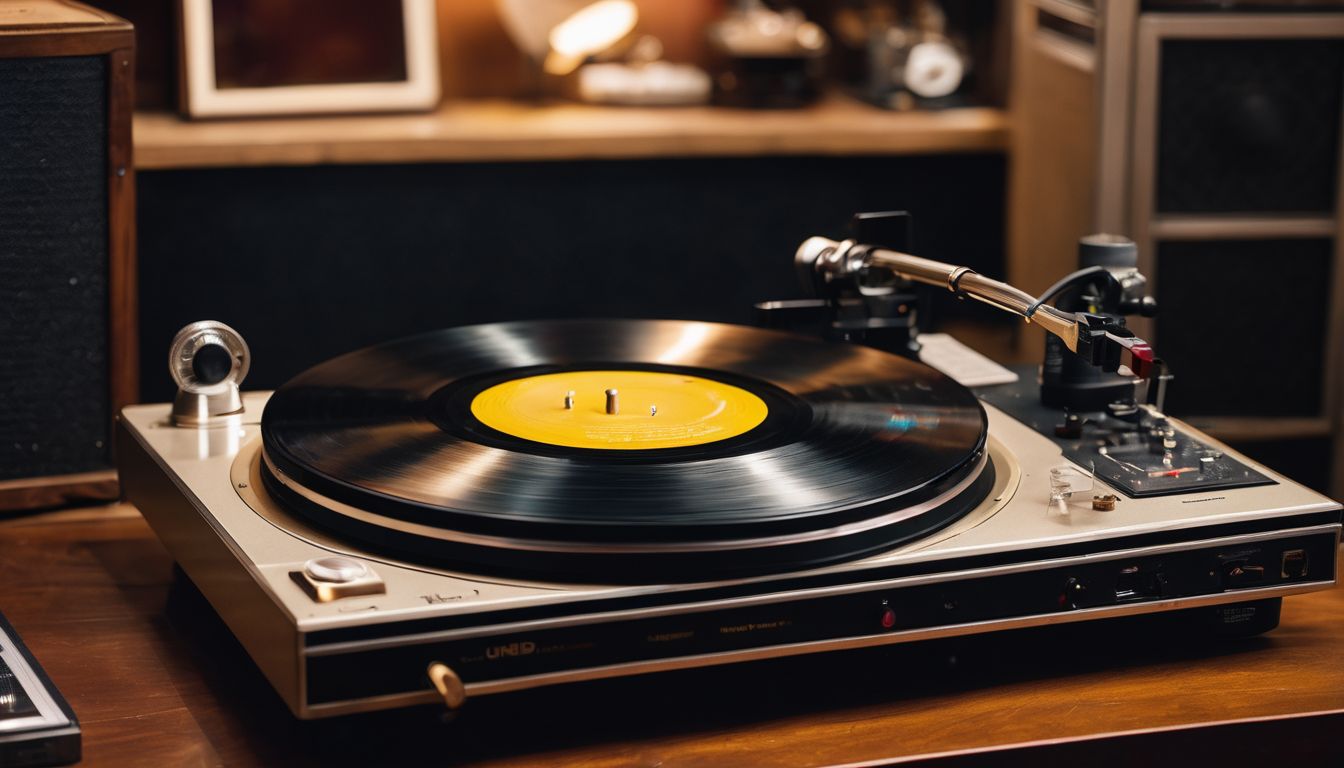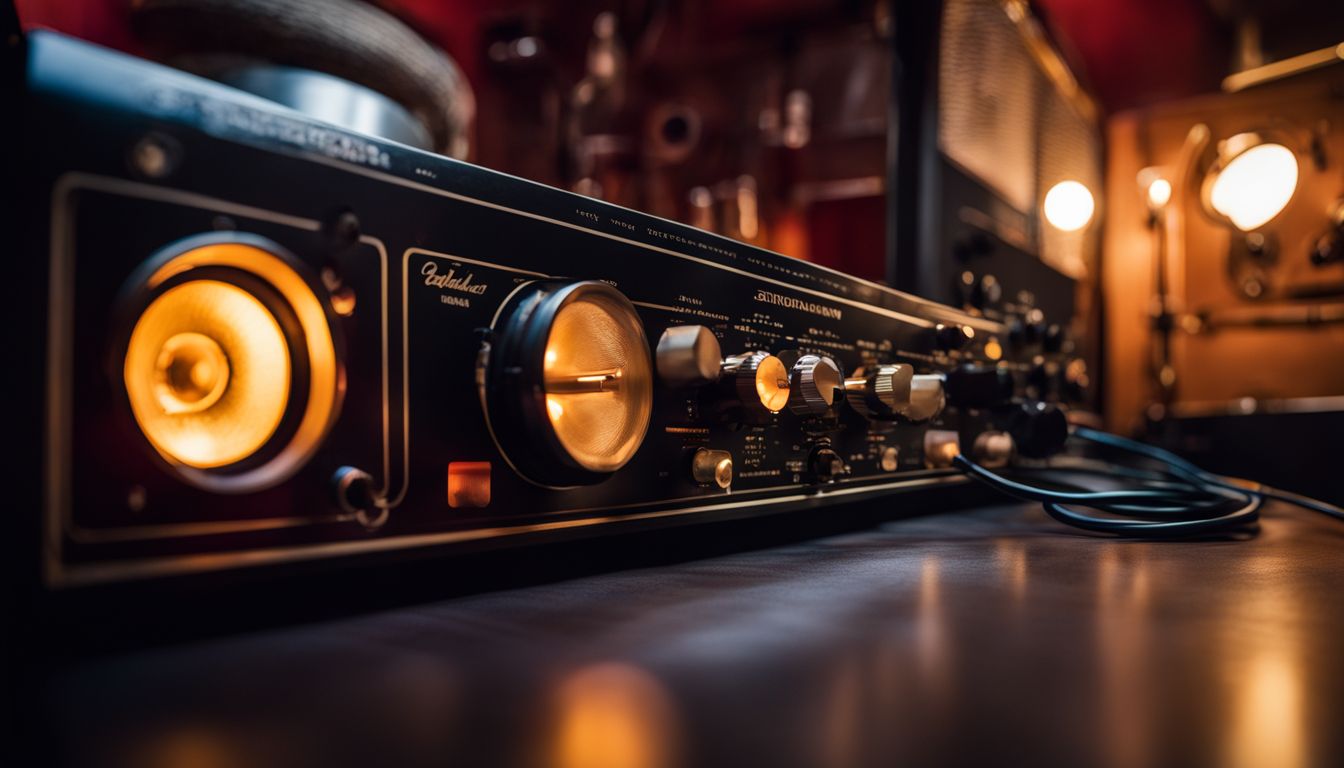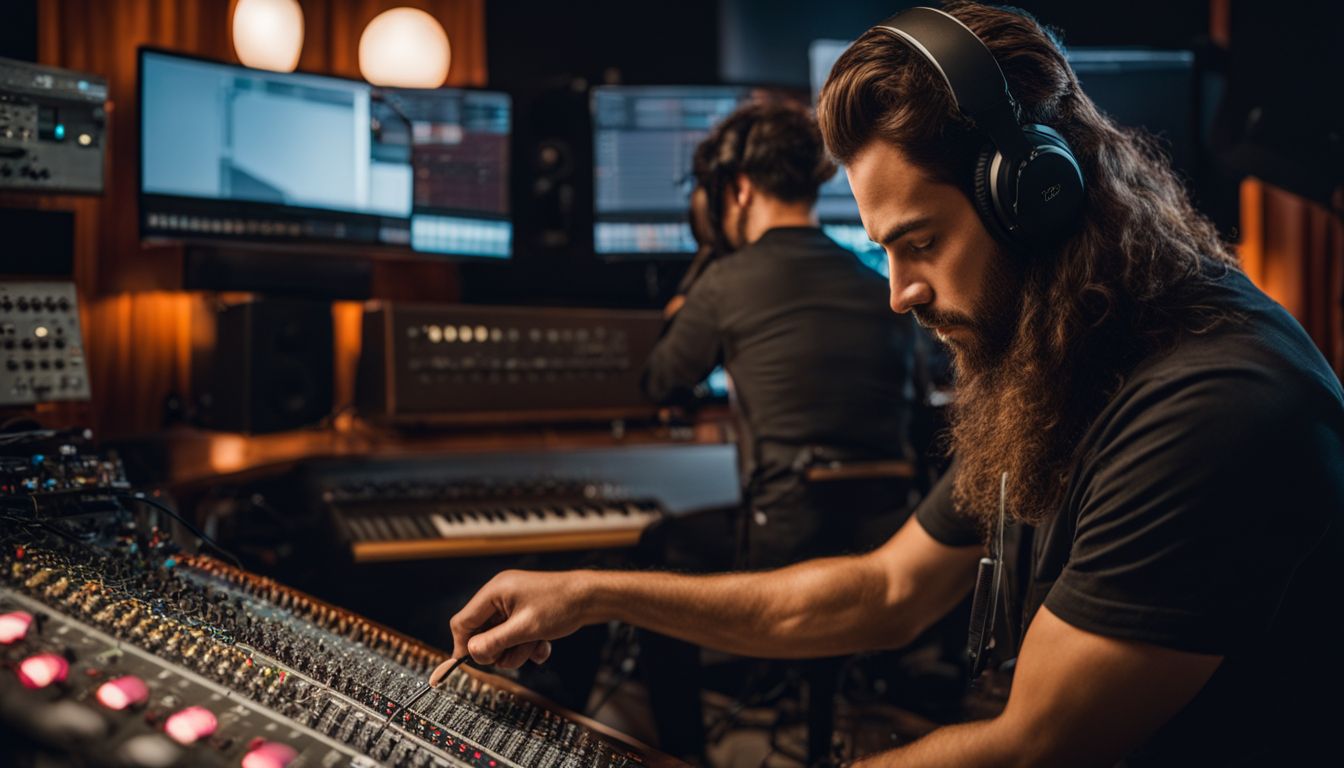Ever notice how your favorite record just doesn’t sound quite right straight from the turntable? That’s where a preamp comes in, giving those tunes the boost they need. Our guide will explore this unsung hero of audio quality, explaining why it might just be the missing piece in your listening experience.
Get ready to elevate your music to new heights!
Key Takeaways
- A preamp amplifies weak audio signals to line level so they can be processed or amplified without losing quality. It’s essential for handling signals from microphones, instruments, and turntables.
- There are different types of preamps. Instrument preamps ensure guitars and other instruments are clear in recordings. Microphone preamps boost mic signals while adding warmth. Phono preamps adjust record player signals following the RIAA EQ curve for accurate vinyl playback.
- Preamps shape sound by providing gain control. They sometimes have tone adjustments. This happens before the sound reaches a power amplifier. The amplifier increases the signal to drive speakers at high volumes.
- When choosing a preamp, consider its compatibility with your equipment. Decide if you need a tube or solid-state technology for your desired sound character. Also, consider additional features like compression and how many channels you’ll need based on your audio setup.
- Professionals rely on studio favorites like Neve, API, and Avalon for top-notch sound recording. Neve offers analog warmth, while Avalon offers transparent amplification.
Understanding What a Preamp is
A preamp serves as the first stage in strengthening audio signals. It acts like a bridge. It takes weak outputs from microphones or phonographs and boosts them to line-level signals. Later stages of an audio system can work with these signals more effectively.
Boosted signals are crucial for further processing. They are needed for recording or amplifying through loudspeakers. Without this initial push, your music would barely be audible.
Think of it as giving your voice a megaphone at a crowded party; the preamp ensures you’re heard over noise. It carefully raises the volume of delicate sounds. It avoids introducing unwanted noise or distortion that could muddy your listening experience.
Different types use varying mechanisms to achieve this. Solid-state amplifier circuits offer consistency; tube amps add warmth. Both audiophiles and professionals frequently desire this warmth.
The Role of a Preamp in Audio Equipment
In the world of audio equipment, a preamp serves as the guardian of sound quality. This crucial component picks up faint electrical signals. It picks up signals from sources like microphones and instruments. It gives them a boost. They can travel through mixers, effects processors, and amplifiers without losing their integrity.
Without a preamp’s delicate touch, these signals could get lost in translation or drown beneath the noise floor. The noise floor is an invisible threshold where quiet sounds disappear into the background hiss.
Preamps inject life into audio. They provide voltage gain to mic-level signals, which would otherwise be too weak to process effectively. They also shape the character and tone before any additional mixing or amplification takes place.
The preamp’s input impedance must match instrument pickups or microphones. This is necessary for optimal sound capture. This harmony ensures that every nuance is faithfully reproduced. Preamps maintain signal clarity across diverse sonic landscapes. They capture the subtle timbre of a classical guitar in a quiet studio. They also reinforce booming vocals at live concerts.
The Differences Between a Preamp and a Power Amplifier
Preamps and power amplifiers serve different functions in the world of audio gear. Each is critical to delivering quality sound. A preamp boosts a low-level input signal, such as from a microphone or instrument pickup. It boosts it to line level, which is strong enough for further processing or amplification.
It’s an essential first stage. It often provides gain control, allowing users to fine-tune volume. Users can also manipulate tone with equalizers or filters. These settings help musicians and producers achieve their desired audio character. They adjust the sound before it reaches the power amp.
A power amplifier takes a line-level signal and amplifies it enough to move speakers and create sound waves. Power amps lack the finesse of controls found on preamps. They focus purely on raw current gain, transforming electrical signals into audible noise. They add distortion effects only when pushed into overdrive.
This increase in amplitude lets live sound audiences hear clear surround sound from passive speakers at high volumes. Your audio interface connects with mixing consoles for an optimal listening experience. It transitions smoothly from precise signal adjustment through preamps. Then it moves to robust amplification via power amps.
Types of Preamps
Diving into the realm of preamps reveals a variety of types, each tailored to enhance specific audio sources. It’s crucial to understand these different preamp configurations. Doing so is crucial for achieving pristine sound quality in any setup. It’s pivotal for fine-tuning vocals with precision and capturing an instrument’s essence.
Preamps for Instruments
Instrument preamps play a key role in capturing the essence of your favorite guitar riff or bass line. These electronic amplifiers take a weak electrical signal from an instrument. For example, they can take the signal from an electric guitar. The instrument might have its own preamp. The amplifier prepares the signal for further processing or amplification.
These devices ensure your instruments sound full and clear through speakers or headphones. It may be a pedal adding tasty guitar distortion or a sleek channel strip on an audio mixing desk.
Guitar amps sometimes aren’t enough to deliver the clarity needed in a recording studio environment. Dedicated instrument preamps offer more control over tone. They can greatly reduce noise, meaning less hiss and hum in your final track.
With these preamps, signal path integrity is enhanced before hitting analog-to-digital converters. This allows musicians to achieve recordings with higher fidelity. Every strummed chord and plucked note resonates as intended without getting noisy or distorted.
Preamps for Microphones
Microphone preamps perform a crucial role in sound recording and live performances. They boost the low output from mics to a more usable level. Whether you’re using a dynamic microphone, known for its durability and ability to handle high sound pressure levels, or a sensitive condenser mic that requires phantom power to operate, having the right mic preamp can make all the difference.
These devices amplify and refine your audio signal. They often add warmth and character, enhancing the overall sound.
When shopping for mic preamps, consider factors like gain control. Also, consider compatibility with your microphones. Don’t just look at the price. Also, look for additional functionalities. For example, high-pass filters eliminate unwanted low frequencies.
Microphone preamps come in various options. Basic models suit home studios. Professional-grade units are used in top recording facilities. There’s a preamp for every need and budget.
Phono preamps take center stage when playing back vinyl records with clarity and depth. They must capture sound accurately.
Phono Preamps
Phono preamps work their magic by taking the faint signal from a record player and giving it a boost. They don’t stop there; they also adjust the frequencies so everything sounds just right.
This includes following the RIAA EQ curve. It ensures that what you hear matches what was originally recorded. This avoids any drops in quality during playbacks. It’s like having a translator for your vinyl records. The translator not only amplifies the conversation but also adjusts the accent. So you get every word loud and clear.
Nowadays, turntables from brands like House of Marley make it even easier for vinyl lovers to dive straight into their collections with less fuss. They come with built-in phono preamps, meaning one less piece of equipment to worry about connecting.
Just plug in and let your favorite tunes fill up the room. These turntables seamlessly combine simplicity with high-quality sound reinforcement.
How to Choose the Right Preamp
Choosing the right preamp is key to capturing high-quality audio. It shapes the character of your sound before it even hits the speaker or recording device. Here’s how you can select the best preamp for your needs:
- Evaluate your main use: Consider if you need a preamp for home theater, digital recording, or live performance. The application will influence whether you should prioritize features like low noise levels or multiple input types.
- Check compatibility: Your preamp must work well with other equipment. This includes microphones, guitar amplifiers, and receivers. Ensure that it can handle different signal levels and connect easily with all of your gear.
- Decide on channels: Some setups demand a two-channel stereo preamp, while others may require a single channel. Know how many channels you’ll need based on the complexity of your audio routing.
- Tube versus solid-state: If you prefer warmer tones with slight harmonic distortion, tube preamps might be your choice. However, if clarity and accuracy are what you’re after, look into solid-state options.
- Consider mic types: Different mics have different needs. For example, condenser mics often require more power. They might benefit from certain microphone preamplifiers. These offer phantom power and the right amount of gain without clipping.
- Think about coloration: Select between a transparent sound or one with more personality. Some prefer pristine clarity, while others want the tonal shaping that some preamps provide for instruments or voices.
- Look at additional features: For example, compression can help manage dynamics directly in the signal flow. It does so before post-processing. This might be crucial for live settings or specific recordings.
- Match it with instruments: If you’re working with instrument amplifiers or rely heavily on the natural tone of guitar pickups, make sure the chosen preamp doesn’t hide their unique sound. Instead, it should enhance them.
- Analyze component quality: High-quality circuitry can improve factors like signal-to-noise ratio (SNR). This impacts the overall sound definition and reduces unwanted noise in quiet passages.
Popular Studio Preamps
Exploring the landscape of studio preamps reveals time-honored favorites. They have shaped the sound of countless records. Learning about their unique characteristics can guide you in crafting your signature sound.
Neve Preamps
Neve preamps stand out in the world of studio equipment for their exceptional warmth and clarity. These traits have secured their spot at the top of many engineers’ must-have lists.
Crafted with meticulous attention to detail, these preamps are hailed for their ability to add a touch of analog magic to recordings. They serve up rich harmonic content and a musical compression that can turn even the most sterile tracks into sonic gold.
Professionals often favor Neve’s signature sound. It has been a defining factor behind countless hit records over the decades. Whether used on vocals or instruments, these preamps provide audio quality that punches through mixes. They have presence and character.
Their robust build quality means they’re not just tools but long-term investments in any studio’s future success.
API Preamps
API preamps stand out in the world of audio for their unique sound character. These preamps are crafted to inject a distinct warmth and punch into recorded signals. They are a favorite among engineers and producers who aim to achieve that classic analog feel in their tracks.
They handle everything, from vocals to guitars, with ease. They capture all the subtleties of the performance without losing any fidelity.
Unlike some tube preamps known for heavy coloration, API preamps strive for clarity. They continue to offer an audio signature that audiophiles adore. Studios around the globe rely on these units for their robust build and reliable performance.
They have useful features like volume controls and input switching. This gives users precise control over their soundscapes. It’s no surprise they’ve become staples in recording environments. Quality cannot be compromised.
Avalon Preamps
Avalon preamps have pristine sound and are consistent. They are a top pick among audio professionals everywhere. These units are known for their transparent, uncolored amplification. They capture the true character of music with remarkable clarity.
Models like the Avalon AD2022 exhibit versatility. They deliver pure, high-quality sound without adding any unwanted color or noise. Artists and engineers lean on this reliability for everything from lush vocals to dynamic instruments.
Studio recordings benefit greatly from an Avalon’s touch. That’s why a model such as the VT-737SP is often an essential piece in many professional setups. The magic of these preamps lies in their ability to bring out the subtle nuances that define high-fidelity recordings.
They provide a clean signal path. It can make all the difference between a good track and a great one. There’s no fuss over complex settings or adjustments. Avalon preamps deliver consistent excellence every time they’re called into action. Whether paired with other studio favorites or used solo.
Conclusion
Stepping into the world of audio, preamps emerge as unsung heroes, fine-tuning signals to perfection. They’re not just volume boosters; they shape sound’s very essence. Whether you’re a vinyl enthusiast or a recording artist, selecting the right preamp breathes life into your music.
Dive into this realm and unlock the full potential of your audio experience. Remember, every nuance in sound quality can be traced back to that crucial piece: the mighty preamp.
If you’re also interested in rounding out your studio gear, check out our article on what a synthesizer is. It’s the electronic heart of many modern music setups.
FAQs
What does a preamp do in audio electronics?
A preamp boosts the low-level signals from devices like phono cartridges. This makes the sound loud enough for further processing or amplification.
Why would I need a preamp for my turntable?
Turntables with moving coils or phono cartridges produce very quiet sounds. They need to be amplified by a preamp before they can be sent to your receiver and played through speakers.
Can a preamp improve the quality of music from my DJ mixer?
Using a high-quality preamp with your DJ mixers can enhance the clarity and richness of the music you play. It makes the music sound even better.
Do all sound systems require a separate preamp?
Not always. Some receivers and computer sound cards have built-in preamps. This is especially true if they are meant to connect directly with phono cartridges or microphones.
How is technology used in modern-day preamps?
Modern preamps may use advanced components. These include switched capacitor circuits or flash analog-to-digital converters. These components improve how they capture and process audio signals efficiently.


